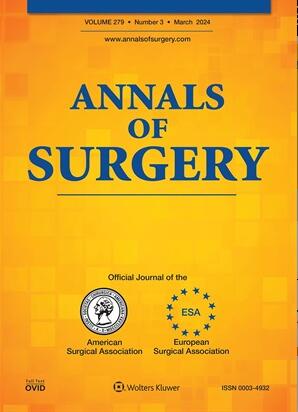Prevalence and Incidence of Oral Benzodiazepine Use in Hospitalized Surgical Patients: A Retrospective Cohort Study.
IF 7.5
1区 医学
Q1 SURGERY
引用次数: 0
Abstract
OBJECTIVE To determine the prevalence of intrahospital oral benzodiazepine use in the surgical population of a tertiary care centre. SUMMARY OF BACKGROUND DATA Oral benzodiazepines used for treating sleep disturbances and anxiety are widely used in the general population. Information regarding benzodiazepine use during hospitalization is scarce. METHODS A retrospective cohort study was conducted using routinely collected healthcare data in a university hospital in Rotterdam, the Netherlands. 10,896 patients representing 14,928 admissions were included in this cohort, corresponding to all adult surgical patients admitted between September 2018 and September 2022. Median age was 62 (50-72) and 8,761 out of 14928 (58.9%) were male. Main outcome measures were prevalence and incidence of oral benzodiazepines usage during hospitalization. RESULTS Prevalence of benzodiazepine administrations in the surgical department was 21.6% out of 14,928 admissions. Median number of tablets given during hospital stay was 3 (1-7). Temazepam (33%), oxazepam (24%) and zopiclone (19%) were prescribed most. Female patients were more likely to have been administered a benzodiazepine, with an adjusted odds ratio of 1.09 (95% confidence interval 1.002 to 1.19). Benzodiazepine administration during admission was positively associated with higher 30-day surgical readmission, with an adjusted odds ratio of 1.37 (1.22 to 1.54). CONCLUSIONS In this study, one fifth of patients admitted to surgical departments were administered oral benzodiazepines for sleep disturbances and anxiety. Future research and policies should focus on finding and implementing effective non-pharmacological methods for perioperative sleep disturbances and anxiety.求助全文
约1分钟内获得全文
求助全文
来源期刊

Annals of surgery
医学-外科
CiteScore
14.40
自引率
4.40%
发文量
687
审稿时长
4 months
期刊介绍:
The Annals of Surgery is a renowned surgery journal, recognized globally for its extensive scholarly references. It serves as a valuable resource for the international medical community by disseminating knowledge regarding important developments in surgical science and practice. Surgeons regularly turn to the Annals of Surgery to stay updated on innovative practices and techniques. The journal also offers special editorial features such as "Advances in Surgical Technique," offering timely coverage of ongoing clinical issues. Additionally, the journal publishes monthly review articles that address the latest concerns in surgical practice.
 求助内容:
求助内容: 应助结果提醒方式:
应助结果提醒方式:


